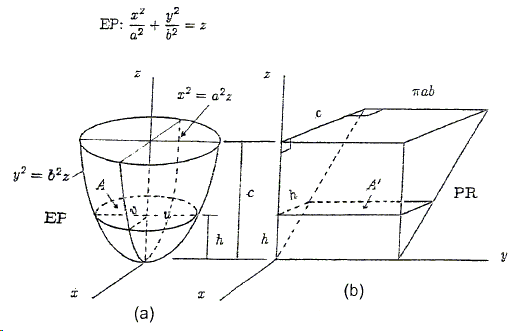Sidney Kung
Volume of an Elliptic Paraboloid
Consider an elliptic paraboloid as shown below, part (a):

At \(z=h\) the cross-section is an ellipse whose semi-mnajor and semi-minor axes are, respectively, \(u\) and \(v\). Since \(u=b\sqrt{h}\), and \(v=a\sqrt{h}\), \(A=\pi abh\). We choose a triangular prism \(PR\) of height \(\pi ab\), and whose cross-section is an isosceles right triangle. At \(z=h\), \(A'=\pi abh=A\). Hence, from (**), the volume of \(EP\) is
\(\displaystyle V_{EP}=\frac{\pi abc^{2}}{2}\)
If the paraboloid is defined by a more dimesionally balanced equation like, say,
\(\displaystyle \frac{x^2}{a^2}+\frac{y^2}{b^2}=\frac{z}{c}\)
then the volume of the paraboloid at height h will be given by
\(\displaystyle V_{EP}=\frac{\pi abh^{2}}{2c}\)
and, for \(h=c\),
\(\displaystyle V_{EP}=\frac{\pi abc}{2}.\)
![]()
- Cavalieri Principle
- A Generalized Cavalieri-Zu Principle
- Area, Sector Area, and Segment Area of an Ellipse
- Volume of a Sphere and Volume of an Ellipsoid
- Volume of an Elliptic Paraboloid
- Volume of a Hyperboloid of One Sheet
- Volume of a Hyperboloid of Two Sheet
- Volume of a Paraboloid of Revolution
![]()
|Contact| |Front page| |Contents| |Geometry|
Copyright © 1996-2018 Alexander Bogomolny73575288
